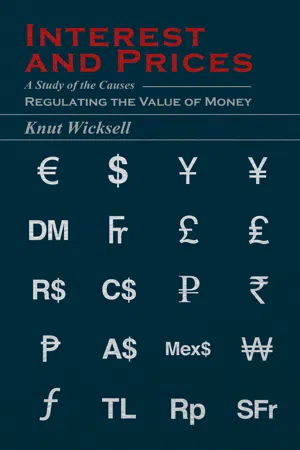Economics
Relative Price
Relative price refers to the price of one good or service in comparison to another. It is a measure of the value of one product in terms of another, often expressed as a ratio. Changes in relative prices can impact consumer behavior and production decisions, influencing the allocation of resources within an economy.
Written by Perlego with AI-assistance
Related key terms
Related key terms
1 of 4
Related key terms
1 of 3
3 Key excerpts on "Relative Price"
- eBook - ePub
Encyclopedia of Political Economy
2-volume set
- Phillip O'Hara(Author)
- 1999(Publication Date)
- Routledge(Publisher)
All major value theories, from classical to early neoclassical, attributed the source of a commodity’s exchange-value to one or more underlying value elements. The underlying value element has been variously identified as the “real costs” of production (exertions of labor, sacrifices in abstaining from consumption in order to provide financial capital), the marginal utility from satisfaction in consumption, labor values, and so on. For MARX, a commodity’s price reflected the amount of socially necessary abstract labor time embodied in its production. For Jevons, the price reflected the intensity of the marginal wants satisfied by consuming the commodity. For Ricardo, price was related to the pain cost of the labor required to produce the commodity.Most of these value theories also attempted (not always successfully) to explain the determination of Relative Prices in terms of differences between commodities in the quantities of the underlying value element(s) that they possessed, embodied or elicited in consumers. These value elements were not only believed to be the source of exchange-value, but were also seen as the regulators of Relative Prices. Relative Prices were viewed as the outcome of the pursuit, avoidance or expression of various human values and “disvalues”—wants, needs, dislikes, efforts, sacrifices—and were viewed as being commensurate with the intensity of these values and disvalues.In some of these theories the distinction between value and price was made explicitly. Marx gave possibly the clearest definition of the distinction between the two, using the very words “value” and “price.” Jevons also gave a clear definition of the distinction between price and his value substance (utility). In some other cases, the distinction was implicit. However, all value theorists recognized that price theory needed to be given a satisfactory value foundation if it was to perform adequately as an explanation of how prices were determined. This value foundation had to link prices to the human processes of valuation that motivate or accompany all labor, production, exchange, consumption and other forms of economic activityThe distinction between value and price is an important one. Price is the appearance and value the underlying essence, to use a Hegelian distinction. Value theory enables us to make sense of the empirical world of Relative Prices, costs, wages and other monetary magnitudes, by relating these back to the underlying human values and disvalues that drive everything. The value foundation of price provides the link between the objective realm of prices and the subjective realm of human values. This also reflects an epistemology and methodology more in tune with the method of Verstehen - Knut Wicksell(Author)
- 2011(Publication Date)
- Josephs Press(Publisher)
isolated exchange between two, or a small number of, individuals. Successive portions of the commodities may then be exchanged at varying prices. The problem of Relative Price in an isolated exchange is for this reason indeterminate, or insufficiently determined; according to the varying degree of calculating ability, cold-bloodedness, and so on, of the individuals engaged in the exchange, the average ratio of interchange of the commodities can fall anywhere within wide limits.It is true that if on an open market the owners of a particular commodity hold back temporarily with the object of raising the price it can easily happen that some of them are able to get rid of their complete stocks (or so much of them as they desire to sell) at the higher price which they exact at the start. But the more pressing requirements of the buyers are now satisfied, and consequently the remaining owners of the commodity must eventually resign themselves to much lower prices for the greater part of their stocks. Similarly, if the buyers hold back temporarily with the purpose of lowering the price it can easily happen that some buyers are able to cover their full needs at a relatively low price. But the stocks of the sellers are now for the most part cleared out, and so the remaining buyers must eventually pay a correspondingly higher price.As a result of the prevalence of competition on both sides, among the sellers and among the buyers, an approximately uniform price for each commodity soon pervades the market. This price is the one at which supply and demand just balance. Such a balance is only possible when the marginal utility is proportional to the price (ratio of interchange) for each commodity and for each individual who takes part in the market.If longer periods of time are being considered, this equilibrium between supply and demand gives way to an equilibrium between production and consumption. As a corollary we find that the price and the cost of production of a commodity are proportional or equal—in so far as the phrase “cost of production” is capable of correct application, or of any application whatever.- eBook - ePub
Value-based Marketing Strategy
Pricing and Costs for Relationship Marketing
- Santiago Lopez(Author)
- 2016(Publication Date)
- Vernon Press(Publisher)
Chapter 4 Price4.1 Definition of Price
In marketing, there are several ways to understand the meaning of "price":- What the customer pays for purchasing a product or service.
- The money he is willing to sacrifice to meet his wants and needs.
- It is an integral part of positioning and may be a signal associated with quality, prestige and status.
- It is the variable that determines the firm´s revenue, income and profitability.
- Price places a value on goods and services, thereby facilitating trade by avoiding the need for barter.
- Price plays a key role by matching supply with demand.
- Sets a trading value for the benefits offered by the product.
- A rising price may signal shortage or high demand.
- A falling price may signal surplus or low demand.
- A high price in relation to cost is a good indicator of a profitable product.
The customer has an economic value for the company, and it is represented by all the profits he generates through his purchases 29 . The set price should be able to achieve customer loyalty and yield the highest present value of the future stream of earnings.4.2 The Dimensions of Price
In general, a product´s price should be set in the context of:- The benefits it offers.
- The product's positioning (its image and perception).
- The target market (needs, profile, habits and preferences).
- The competition (prices and benefits).
- Market forces (supply and demand).
- Differentiation and / or competitive advantage.
- The product´s life cycle.
- Business trends.
In a high-end market segment, a high price is perceived as an indication of quality, prestige and status. When a price is too low, it is likely to be associated with lower quality and therefore have a negative effect on the product´s positioning; it may adversely affect the brand´s image.Prices that do not fit with the target market, or with the product´s positioning, can be found frequently. A good example is a restaurant, where the food may be inexpensive but drinks expensive; beverage consumption will therefore be lower than what it could be. Another example might be a movie theater with very high prices in snacks and beverages, thereby reducing the sales potential within the target market.
Index pages curate the most relevant extracts from our library of academic textbooks. They’ve been created using an in-house natural language model (NLM), each adding context and meaning to key research topics.
Explore more topic indexes
Explore more topic indexes
1 of 6
Explore more topic indexes
1 of 4


